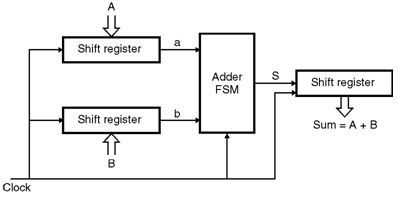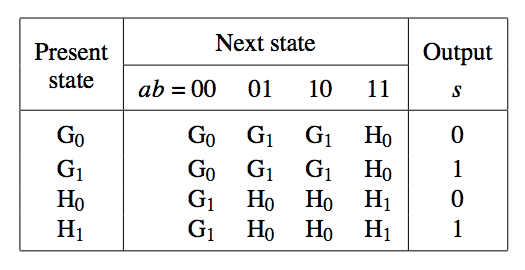

Now you have to update all schematic files. After selecting it, expand " Design Utilities" section and press on " Create Schematic Symbol". In order to overcome this, you should create a symbol for the full adder module by going to " Sources" -> " Implementation" and choosing the " FA - FullAdder" line under " FourBitSerialAdderSubtractor" top design. If you press on "Generate Programming File" under "Processes" panel, you will get an error:
SERIAL ADDER VHDL SERIAL
The module is used in the top 4-bit serial adder/subtractor design. Its schematics is given below: Schematics of the full adder module. Full adder circuit is used as a module " FullAdder.sch". The symbols labeled with "M2_1" are 2-to-1 multiplexers. Number "B" can be negated in two’s complement form allowing subtraction operation mode.



If you click on " FourBitSerialAdderSubtractor.sch" file in the top design, you will see the circuit of the 4-bit serial adder/subtractor with parallel load as shown below: Schematics of the 4-bit serial adder/subtractor with parallel load drawn in Xilinx ISE.
SERIAL ADDER VHDL ARCHIVE
The new version is not covered in this tutorial.Ĭreate a new project with name "FourBitSerialAdderSubtractorSCH" and add exisiting source files from the archive provided: Newer version of the code (commit 92c9460c533a0748104cbfb56988732b5c4095b8) contains 7-segment display and a bus, which groups individual bits of numbers A and B. Schematic Design in Xilinx ISEĬlone the project and checkout commit 5c385071530140074c8aa53dc40297b752ab0bd7: Hence the circuit performs rotation operation for register B_REG. The least significant bit of B_REG is fed to the input of the most significant bit of B_REG. For this purpose one D-type flip-flop is used as a temporary storage element. Carry-out output produced after each cycle is fed back to the full adder as a carry-in of the next significant bit. The sum is stored at the most significant bit of register A_REG. Starting with the least significant bit, at each cycle one bit of number A and one bit of number B are being added. The addition of numbers stored in A_REG and B_REG requires 4 cycles. After loading registers with numbers, shifting mode should be enabled to perform the arithmetic operation. Loading of numbers from inputs A, B to registers A_REG, B_REG occurs in one clock cycle. In order to load registers A_REG and B_REG with numbers, shift capability of the registers should be disabled and loading mode should be enabled. Two right-shift registers with parallel load, “A” and “B” a full adder FA, and a D-type flip-flop for storing carry-out are used. A simplified schematics of the circuit is shown below: Simplified schematics of the 4-bit serial adder with parallel load. The CircuitĪ 4-bit serial adder circuit consists of two 4-bit shift registers with parallel load, a full adder, and a D-type flip-flop for storing carry-out. All code is written for Basys2 development board and Xilinx ISE was used as a synthesizer/simulator. However, basic understanding of the circuits is necessary, so both schematics and VHDL implementations are given. "4-bit Serial Adder/Subtractor with Parallel Load" is a simple project which may help to understand use of variables in the "process" statement in VHDL. This is a tutorial I wrote for the "Digital Systems Design" course as an introduction to sequential design.


 0 kommentar(er)
0 kommentar(er)
